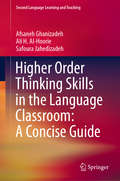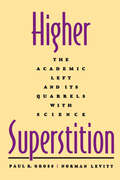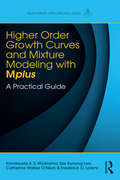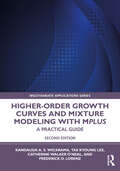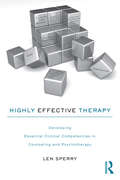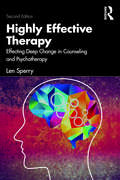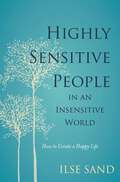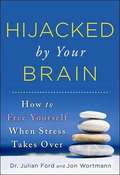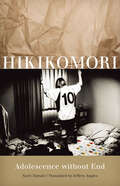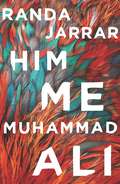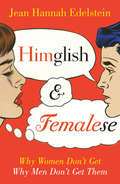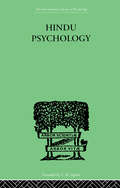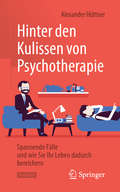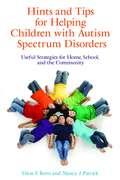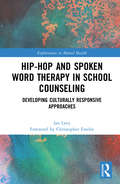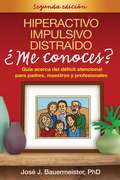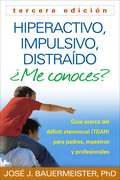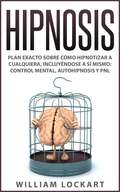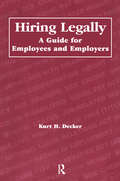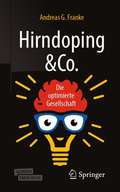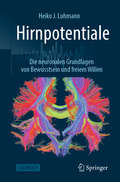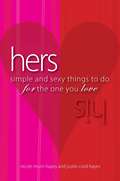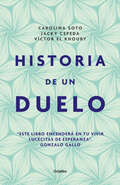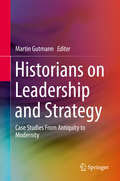- Table View
- List View
Higher Order Thinking Skills in the Language Classroom: A Concise Guide (Second Language Learning and Teaching)
by Afsaneh Ghanizadeh Ali H. Al-Hoorie Safoura JahedizadehIn this book, we try to provide a practical, down-to-earth guide for those who are involved in language learning and teaching. We hope that this book will be a useful reading for those who would like to incorporate higher-order thinking skills (HOTS)-enhancing techniques in their teaching practice. We set out from the position that, although it is hardly doubtful that it is at the heart of education, critical thinking is in reality often not given its due attention in pedagogy, particularly in language education. This book offers readers some practical advice on how to implement HOTS in their own practice. It has been written to take the reader through each technique with the ultimate goal of promoting HOTS step-by-step. In the introductory chapter, we present an overview of the theory behind HOTS, its definition, its relation to Bloom’s Taxonomy, its two dimensions (critical thinking and reflective thinking), and the ideas of some influential thinkers in this area. The subsequent chapters present six HOTS-enhancing techniques that classroom teachers can draw from, namely graphic organizers, critical discourse analysis, argumentation, emotion regulation and emotional intelligence enhancing techniques, reflective journals, and mindfulness-based strategies. As the book draws on a wide-ranging review of literature with exercises for direct use with language learners, we hope that this provides both theoretical and practical support for the teaching process to help language learners become effective critical thinkers. The compilation of the ideas in this book took us a long time, over a decade. Something that takes such a long time requires much engagement and life experience; so did this book.
Higher Superstition: The Academic Left and Its Quarrels with Science
by Paul R. Gross Norman LevittThe widely acclaimed response to the postmodernists attacks on science, with a new afterword.With the emergence of "cultural studies" and the blurring of once-clear academic boundaries, scholars are turning to subjects far outside their traditional disciplines and areas of expertise. In Higher Superstition scientists Paul Gross and Norman Levitt raise serious questions about the growing criticism of science by humanists and social scientists on the "academic left." This edition of Higher Superstition includes a new afterword by the authors.
Higher-Order Growth Curves and Mixture Modeling with Mplus: A Practical Guide (Multivariate Applications Series)
by Kandauda K.A.S. Wickrama Tae Kyoung Lee Catherine Walker O’Neal Frederick O. LorenzThis practical introduction to second-order and growth mixture models using Mplus introduces simple and complex techniques through incremental steps. The authors extend latent growth curves to second-order growth curve and mixture models and then combine the two. To maximize understanding, each model is presented with basic structural equations, figures with associated syntax that highlight what the statistics mean, Mplus applications, and an interpretation of results. Examples from a variety of disciplines demonstrate the use of the models and exercises allow readers to test their understanding of the techniques. A comprehensive introduction to confirmatory factor analysis, latent growth curve modeling, and growth mixture modeling is provided so the book can be used by readers of various skill levels. The book’s datasets are available on the web. Highlights include: -Illustrative examples using Mplus 7.4 include conceptual figures, Mplus program syntax, and an interpretation of results to show readers how to carry out the analyses with actual data. -Exercises with an answer key allow readers to practice the skills they learn. -Applications to a variety of disciplines appeal to those in the behavioral, social, political, educational, occupational, business, and health sciences. -Data files for all the illustrative examples and exercises at www.routledge.com/9781138925151 allow readers to test their understanding of the concepts. -Point to Remember boxes aid in reader comprehension or provide in-depth discussions of key statistical or theoretical concepts. Part 1 introduces basic structural equation modeling (SEM) as well as first- and second-order growth curve modeling. The book opens with the basic concepts from SEM, possible extensions of conventional growth curve models, and the data and measures used throughout the book. The subsequent chapters in part 1 explain the extensions. Chapter 2 introduces conventional modeling of multidimensional panel data, including confirmatory factor analysis (CFA) and growth curve modeling, and its limitations. The logical and theoretical extension of a CFA to a second-order growth curve, known as curve-of-factors model (CFM), are explained in Chapter 3. Chapter 4 illustrates the estimation and interpretation of unconditional and conditional CFMs. Chapter 5 presents the logical and theoretical extension of a parallel process model to a second-order growth curve, known as factor-of-curves model (FCM). Chapter 6 illustrates the estimation and interpretation of unconditional and conditional FCMs. Part 2 reviews growth mixture modeling including unconditional growth mixture modeling (Ch. 7) and conditional growth mixture models (Ch. 8). How to extend second-order growth curves (curve-of-factors and factor-of-curves models) to growth mixture models is highlighted in Chapter 9. Ideal as a supplement for use in graduate courses on (advanced) structural equation, multilevel, longitudinal, or latent variable modeling, latent growth curve and mixture modeling, factor analysis, multivariate statistics, or advanced quantitative techniques (methods) taught in psychology, human development and family studies, business, education, health, and social sciences, this book’s practical approach also appeals to researchers. Prerequisites include a basic knowledge of intermediate statistics and structural equation modeling.
Higher-Order Growth Curves and Mixture Modeling with Mplus: A Practical Guide (Multivariate Applications Series)
by Tae Kyoung Lee Catherine Walker O’Neal Frederick O. Lorenz Kandauda A.S. WickramaThis practical introduction to second-order and growth mixture models using Mplus introduces simple and complex techniques through incremental steps. The authors extend latent growth curves to second-order growth curve and mixture models and then combine the two using normal and non-normal (e.g., categorical) data. To maximize understanding, each model is presented with basic structural equations, figures with associated syntax that highlight what the statistics mean, Mplus applications, and an interpretation of results. Examples from a variety of disciplines demonstrate the use of the models and exercises allow readers to test their understanding of the techniques. A comprehensive introduction to confirmatory factor analysis, latent growth curve modeling, and growth mixture modeling is provided so the book can be used by readers of various skill levels. The book’s datasets are available on the web. New to this edition: * Two new chapters providing a stepwise introduction and practical guide to the application of second-order growth curves and mixture models with categorical outcomes using the Mplus program. Complete with exercises, answer keys, and downloadable data files. * Updated illustrative examples using Mplus 8.0 include conceptual figures, Mplus program syntax, and an interpretation of results to show readers how to carry out the analyses with actual data. This text is ideal for use in graduate courses or workshops on advanced structural equation, multilevel, longitudinal or latent variable modeling, latent growth curve and mixture modeling, factor analysis, multivariate statistics, or advanced quantitative techniques (methods) across the social and behavioral sciences.
Highly Effective Therapy: Developing Essential Clinical Competencies in Counseling and Psychotherapy
by Len SperryMental health professionals and accrediting bodies have steadily been embracing competency-focused learning and clinical practice. In contrast to a skill, a competency is a level of sufficiency evaluated against an external standard. Learning to be clinically competent involves considerably more than the current emphasis on skill and micro skill training. While there are now a small number of books that describe the various clinical competencies of counseling and psychotherapy, none of these books focus on how to learn them. Highly Effective Therapy emphasizes the process of learning these essential competencies. It illustrates them in action with evidence-based treatment protocols and clinical simulations to foster learning and competency. Highly Effective Therapy is a hands-on book that promotes learning of the 20 competencies needed for effective and successful clinical practice.
Highly Effective Therapy: Effecting Deep Change in Counseling and Psychotherapy
by Len SperryTrainees and practitioners need a trusted resource for mastering the essential skills and competencies necessary for effecting deep, lasting change in their clients. This second edition of Highly Effective Therapy: Effecting Deep Change in Counseling and Psychotherapy is that resource. It updates the 20 essential skill sets and clinical competencies needed for a highly effective and successful clinical practice. It illustrates them in action with evidence-based treatment protocols and clinical simulations to foster learning and competency. Sperry emphasizes the process of easily learning these research-based clinical competencies with added case examples and session transcriptions. New to this edition is trauma assessment, protective factors, and ultra-brief cognitive behavioral interventions. This second edition is written in an accessible format and is essential for practitioners, trainees, and instructors working in this field.
Highly Sensitive People in an Insensitive World: How to Create a Happy Life
by Elisabeth Svanholmer Ilse SandIn today's fast-paced, increasingly public society, we are expected to be resilient, to have the energy to manage a packed work schedule, social calendar, and a large network of friends, both online and offline, day and night. If you find yourself struggling to live up to, or even enjoy, these non-stop social expectations, then this book is for you. Written for highly sensitive people, the book explains the characteristics of being highly sensitive and how to overcome common difficulties, such as low self-esteem and the exhausting effects of socialising. Ilse Sand also encourages you to explore and appreciate the advantages of high sensitivity, including your aptitude for depth, intensity and presence, and suggests activities to calm and inspire.
Hijacked by Your Brain: How to Free Yourself When Stress Takes Over
by Julian Ford Jon WortmannHijacked by Your Brain is the first book to explain how stress changes your brain and what you can do about it. Stress is not the enemy. In order to reduce stress, you have to understand why your brain causes you to feel stress and how you can take advantage of it to handle the high-stress people and situations in your life. This groundbreaking book reveals the step missing in most stress reduction guides. We can't stop stress, but we can control the effect stress has on us. Hijacked by Your Brain is the user's manual for your brain that shows you how to free yourself when stress takes over.
Hikikomori: Adolescence without End
by Saito TamakiThis is the first English translation of a controversial Japanese best seller that made the public aware of the social problem of hikikomori, or &“withdrawal&”—a phenomenon estimated by the author to involve as many as one million Japanese adolescents and young adults who have withdrawn from society, retreating to their rooms for months or years and severing almost all ties to the outside world. Saitō Tamaki&’s work of popular psychology provoked a national debate about the causes and extent of the condition. Since Hikikomori was published in Japan in 1998, the problem of social withdrawal has increasingly been recognized as an international one, and this translation promises to bring much-needed attention to the issue in the English-speaking world. According to the New York Times, &“As a hikikomori ages, the odds that he&’ll re-enter the world decline. Indeed, some experts predict that most hikikomori who are withdrawn for a year or more may never fully recover. That means that even if they emerge from their rooms, they either won&’t get a full-time job or won&’t be involved in a long-term relationship. And some will never leave home. In many cases, their parents are now approaching retirement, and once they die, the fate of the shut-ins—whose social and work skills, if they ever existed, will have atrophied—is an open question.&”Drawing on his own clinical experience with hikikomori patients, Saitō creates a working definition of social withdrawal and explains its development. He argues that hikikomori sufferers manifest a specific, interconnected series of symptoms that do not fit neatly with any single, easily identifiable mental condition, such as depression. Rejecting the tendency to moralize or pathologize, Saitō sensitively describes how families and caregivers can support individuals in withdrawal and help them take steps toward recovery. At the same time, his perspective sparked contention over the contributions of cultural characteristics—including family structure, the education system, and gender relations—to the problem of social withdrawal in Japan and abroad.
Him, Me, Muhammad Ali
by Randa JarrarIn her first story collection, Jarrar employs a particular, rather than rhetorical approach to race and gender. Thus we have "How Can I Be of Use to You," with its complicated relationship between a distinguished Egyptian feminist and her young intern, demonstrating that gender politics are never straightforward, and both generations-old and new-take advantage of each other. There's also a healthy dose of magic surrealism, as in the wild and witty story "Zelda the Halfie" which follows a breed of half Ibexes/half humans and their various tribulations. The writing is peppered with gorgeous imagery: a moon reflected in an ice cream scoop, breath that runs ahead of its body, and two apartments in a high rise whose tenants precisely mirror each other.Randa Jarrar is the author of a highly successful novel, A Map of Home, which received an Arab-American Book Award and was named one of the best novels of 2008 by the Barnes & Noble Review. She grew up in Kuwait and Egypt, and moved to the United States after the first Gulf War. Her work has appeared in the New York Times Magazine, the Utne Reader, Salon.com, Guernica, the Rumpus, the Oxford American, Ploughshares, and more. She blogs for Salon, and lives in California.
Himglish and Femalese: Why women don't get why men don't get them
by Jean Hannah EdelsteinAs we tumble headlong into the second decade of the third millennium, we are in an era of unprecedented freedom to be whatever we want to be, in defiance of fusty old gender stereotypes. But while the women revel in ruling the boardroom, the men make magic in the kitchen, and everyone does rather unusual things in the bedroom, all of this freedom does have its downside: without understanding the fundamental differences between the genders, we're in for an era of dire confusion when it comes to living with the other half of humanity.But don't furrow your brow. Jean Hannah Edelstein is here to lead you through the perplexing questions of what it means to be a man or a woman in the twenty-first century.With a spectacular talent for unpicking social trends, Edelstein draws equally on experiential and anecdotal evidence, as well as the latest scientific studies, delivering a witty, edgy and definitive manual to understanding your partner/husband/boyfriend/girlfriend. Welcome a fresh new expert on men and women and the contradictory languages they speak.
Hindu Psychology: Its Meaning for the West (International Library Of Psychology Ser.)
by Swami AkhilanandaThe six volume Psychology ann Religion set of the International Library of Psychology explores the interface between psychology and religion, looking at aspects of religious belief and mysticism as related to the study of human consciousness. Hindu Psychology looks at the relevance of Hindu belief systems and theories of perception for the West.
Hinter den Kulissen von Psychotherapie: Spannende Fälle und wie Sie Ihr Leben dadurch bereichern
by Alexander HüttnerSie wollten schon immer einmal wissen, was in einer Psychotherapie passiert? Was tun Therapeuten, um ihre Klienten bei der Bewältigung psychischer Krisen zu begleiten und zu unterstützen? Und welche Hintergedanken haben Therapeuten eigentlich dabei?Dieses Sachbuch gewährt einen Blick hinter die Kulissen von Psychotherapie und damit Einblicke in die Arbeit und Gedanken eines Therapeuten. Anhand realer Fälle werden alltagsnahe Problemen wie z.B. Angst, Hilflosigkeit, Unzufriedenheit in der Ehe oder Depressionen dargestellt. Dank zusätzlicher Analyse erfahren Sie leicht verständlich, wie psychotherapeutische Arbeit abläuft, wie diese gelingen oder auch scheitern kann. Lernen Sie zudem, wie Sie aus den Fallbeschreibungen anhand eines einfach verständlichen Prinzips wichtige Schlüsse für Ihr eigenes Leben ziehen können, um dieses zufrieden und selbstbestimmt leben zu können.
Hints and Tips for Helping Children with Autism Spectrum Disorders: Useful Strategies for Home, School, and the Community
by Dion Betts Nancy J PatrickIf you have a child on the autism spectrum who struggles with the challenges of daily life, then this book is for you! Hints and Tips... is peppered with vignettes and stories of real-life situations and successes, and offers clever ideas for tackling everyday difficulties, such as bathing, bedtime, school trips, and selecting the right child minder. Dion E. Betts and Nancy J. Patrick provide creative, practical strategies to help parents and caregivers to support their child, and to enable their child to develop the social skills needed to manage and enjoy daily life to the fullest. The book is split into five parts: home life, hygiene, community, medical, and schools and organizations. Common problem areas are also tackled in a toolkit section, which includes checklists, 'to do' lists, visual schedules, and mnemonics to aid memory and retrieval. Hints and Tips for Helping Children with Autism Spectrum Disorders is an essential aid for parents and carers to make small and simple changes that result in big improvements in the quality of life of children, their families, and carers.
Hip-Hop and Spoken Word Therapy in School Counseling: Developing Culturally Responsive Approaches (Explorations in Mental Health)
by Ian LevyThis volume recognizes the need for culturally responsive forms of school counseling and draws on the author’s first-hand experiences of working with students in urban schools in the United States to illustrate how hip-hop culture can be effectively integrated into school counseling to benefit and support students. Detailing the theoretical development, practical implementation and empirical evaluation of a holistic approach to school counseling dubbed "Hip-Hop and Spoken Word Therapy" (HHSWT), this volume documents the experiences of the school counsellor and students throughout a HHSWT pilot program in an urban high school. Chapters detail the socio-cultural roots of hip-hop and explain how hip-hop inspired practices such as writing lyrics, producing mix tapes and using traditional hip-hop cyphers can offer an effective means of transcending White, western approaches to counseling. The volume foregrounds the needs of racially diverse, marginalized youth, whilst also addressing the role and positioning of the school counselor in using HHSWT. Offering deep insights into the practical and conceptual challenges and benefits of this inspiring approach, this book will be a useful resource for practitioners and scholars working at the intersections of culturally responsive and relevant forms of school counseling, spoken word therapy and hip-hop studies.
Hiperactivo, Impulsivo, Distraído ¿Me conoces?, Segunda edición
by José J. BauermeisterEscrita específicamente para los padres y los maestros de habla hispana, esta guía práctica y realista ofrece consejos esenciales para ayudar a los niños con el TDA o el TDAH. El destacado experto, Dr. José J. Bauermeister, extrae los conocimientos científicos más recientes sobre estos problemas y describe medidas claras que se pueden tomar para reforzar las habilidades de su niño, encontrar los tratamientos apropiados, promover el éxito escolar y mejorar su comportamiento tanto en la casa como en la escuela. A lo largo de su carrera, el Dr. Bauermeister se ha dedicado a trabajar con niños y familias hispanas, cuyas experiencias y cultura únicas están reflejadas en cada página. El contenido especial de esta edición incluye la información más actualizada sobre los medicamentos y cuándo (y cuándo no) se deben usar; el problema del TDAH en las niñas, frecuentemente pasado por alto; cómo explicar el trastorno a los niños; consejos para aumentar la autoestima, y mucho más. Written specifically for Spanish-speaking parents and teachers, this practical, down-to-earth resource offers essential guidance for helping children with ADD or ADHD. Leading expert Dr. José J. Bauermeister distills the latest scientific knowledge about these problems and describes clear steps you can take to build on your child's strengths, find the right treatments, promote school success, and improve behavior both at home and in school. Dr. Bauermeister has devoted his career to working with Hispanic children and families, whose unique experiences and culture are reflected on every page. Special features of this edition include the latest information on medications and when (and when not) to use them, the often-overlooked problem of ADHD in girls, how to explain the disorder to kids, tips to increase self-esteem, and much more.
Hiperactivo, Impulsivo, Distraído ¿Me conoces?, Tercera edición
by Russell A. Barkley José J. BauermeisterSi su hijo ha recibido un diagnóstico del trastorno por déficit de atención con hiperactividad (TDAH), usted necesita orientación y apoyo en los que pueda confiar. Ha llegado al lugar correcto. Uno de los principales expertos, el Dr. José J. Bauermeister, explica, con claridad, la naturaleza de los problemas de atención y las razones por las que los niños con estos trastornos actúan como lo hacen. Usted aprenderá estrategias cuya eficacia ha sido comprobada para superar los frustrantes problemas de la conducta, para ayudar a su hijo a tener éxito en la escuela y, de ser necesario, para encontrar la ayuda profesional adecuada. El Dr. Bauermeister ha dedicado su carrera a trabajar con niños hispanos y con familias hispanas cuyas experiencias y culturas distintivas se reflejan en cada página. Escrito en español (no traducido), este libro es un recurso único para ayudarlo(a) a usted a satisfacer las necesidades de su hijo. Además, proporciona información esencial para maestros y otros profesionales. Esta tercera edición, revisada y actualizada, incluye la investigación científica y las estrategias de tratamiento más recientes. If your child has been diagnosed with attention-deficit/hyperactivity disorder (ADHD), you need guidance and support that you can trust. You've come to the right place. Leading expert Dr. José J. Bauermeister clearly explains the nature of attention problems and why children with these disorders act the way they do. You'll learn proven strategies for overcoming frustrating behavior problems, helping your son or daughter succeed in school, and, if needed, finding the right professional help. Dr. Bauermeister has devoted his career to working with Hispanic children and families, whose unique experiences and culture are reflected on every page. Written in Spanish (not a translation), this is a unique resource to help you meet the needs of your child. It also provides essential information for teachers and other professionals. Revised and updated, the third edition includes the latest scientific research and treatment strategies.
Hipnosis
by William LockhartSu arma es la lucha contra el estrés. ¿Está usted buscando maneras para mitigar el estrés? ¿Ha buscado y no ha encontrado nada que parezca funcionar? Puede que usted no esté familiarizado con esto, pero, ¿sabe usted que la hipnosis puede eliminar todo el estrés que está sintiendo justo ahora? En general, el poder de nuestra mente nos puede hacer sentir cosas que, en primer lugar, ni siquiera deberían estar ahí. Cuando sembramos buenas semillas en nuestra mente, se refleja en el exterior y lo mismo ocurre también cuando sembramos las malas. ¿Alguna vez escuchó decir: “Lo que piensas, se manifiesta”? Estoy seguro de que sí. Aquí es donde aparece el hipnotismo. Es una herramienta terapéutica que produce un equilibrio tanto mental como emocional. También se ha demostrado que proporciona relajación física, alivio del dolor, un mejor sueño y reduce la ansiedad. Aunque la palabra ‘hipnosis’ resulta bastante fuerte para muchas personas, se considera segura cuando se realiza con las precauciones adecuadas. En este libro se comentan 4 temas: ¿Qué es el hipnotismo? Autohipnosis – Preparación El juego real: Fase II y Fase III Cómo hipnotizar a una persona Esta es su guía didáctica para practicar el hipnotismo. Cuenta con detalles completos que satisfarán su entendimiento y ¡harán que tenga una experiencia exitosa! La hipnosis no está limitada únicamente para uno mismo; ciertamente puede hacerlo a otras personas que estén dispuestas a someterse a esta terapia. Todo lo que usted necesita es práctica.
Hiring Legally: A Guide for Employees and Employers
by Kurt H. DeckerThe principles, procedures, and policies applicable to hiring are reviewed by this book to assist in minimizing litigation risks for employers and acquainting employees with these employer procedures to protect their disclosures of non-job-related information. Areas covered include the hiring process, pre-employment screening fundamentals, data verification, and federal and state statutes affecting the hiring process.
Hirndoping & Co.: Die optimierte Gesellschaft
by Andreas G. FrankeLeistungssteigerung per Pille oder kurz „Hirndoping“ ist zu einem regelrechten Trend geworden, der innerhalb weniger Jahre besorgniserregende Ausmaße angenommen hat. Doch wie kommt das?Das Buch beleuchtet das brisante Thema „Hirndoping" erstmals aus zahlreichen Blickwinkeln wie Soziologie, Medizin, Sport- und Rechtswissenschaften und vielen weiteren Disziplinen.Es zeichnet den Weg von der Agrargesellschaft, in der die Geschwindigkeit des Lebens von den natürlichen Gegebenheiten abhing, bis in die heutige Zeit nach. Eine Zeit, in der es durch Globalisierung und Digitalisierung vermeintlich keine Grenzen mehr gibt. Die letzte Grenze, die es zu überwinden gilt, scheint unser Geist. „Hirndoping“ bietet sich hier als Antwort aus den Regalen der Arzneimittelindustrie an. Eine Antwort, die aber nur begrenzt funktioniert und die gesundheitlich, juristisch und ethisch nicht frei von Risiken und Nebenwirkungen ist. Alternativlos ist „Hirndoping“ jedenfalls nicht.
Hirnpotentiale: Die neuronalen Grundlagen von Bewusstsein und freiem Willen
by Heiko J. LuhmannDer Neurophysiologe Heiko Luhmann erforscht seit mehr als 35 Jahren die Funktionsweise von Nervenzellen und neuronalen Netzen. In diesem spannenden und provozierenden Buch informiert er Sie über die neuesten Erkenntnisse der Hirnforschung und wie diese unsere Vorstellungen über das Bewusstsein und den freien Willen verändern. Sie erfahren, dass die Trennung von Körper und Geist aus neurowissenschaftlicher Sicht nicht aufrechterhalten werden kann und wie unterschiedliche Wissenschaftsdisziplinen ein neues Konzept zur Funktionsweise unseres Gehirns entwickeln. Das Buch beschäftigt sich mit spannenden grundlegenden Fragen, wie:Warum gibt es überhaupt Gehirne? Wie kommt die Welt in den Kopf? Wie sind interne neuronale Karten aufgebaut? Wo ist das Bewusstsein lokalisiert und wie entsteht es? Hat der Oktopus ein Bewusstsein? Ist das Gehirn eine Prädiktionsmaschine? Erlaubt das Konzept der prädiktiven Kodierung einen freien Willen? Entwickeln wir mit Hilfe eines Hirn-Computer-Interfaces ein höheres Bewusstein? Sind wir technologisch in der Lage Gedanken zu lesen und zu erzeugen? Verfügen Roboter eines Tages über ein künstliches Bewusstsein?
Hiroshima
by Ran ZwigenbergIn 1962, a Hiroshima peace delegation and an Auschwitz survivor's organization exchanged relics and testimonies, including the bones and ashes of Auschwitz victims. This symbolic encounter, in which the dead were literally conscripted in the service of the politics of the living, serves as a cornerstone of this volume, capturing how memory was utilized to rebuild and redefine a shattered world. This is a powerful study of the contentious history of remembrance and the commemoration of the atomic bomb in Hiroshima in the context of the global development of Holocaust and World War II memory. Emphasizing the importance of nuclear issues in the 1950s and 1960s, Zwigenberg traces the rise of global commemoration culture through the reconstruction of Hiroshima as a 'City of Bright Peace', memorials and museums, global tourism, developments in psychiatry, and the emergence of the figure of the survivor-witness and its consequences for global memory practices.
His/Hers: Simple And Sexy Things to Do for the One You Love
by Justin Cord Hayes Nicole Murn HayesThis flip-book gives you two books for the price of one—including suggestions for men in one direction, and when you flip the book over, suggestions for women on the other. This romantic book provides creative gestures to keep romance alive in your relationship.
Historia de un duelo
by Carolina Soto Víctor El Khoury Jacky Cepeda"ESTE LIBRO ENCENDERÁ EN TU VIVIR LUCECITAS DE ESPERANZA". GONZALO GALLO En el año 2015 un accidente fatal cambió para siempre las vidas de la familia de Sofía El Khoury, hija de Víctor El Khoury y Jacky Cepeda, y hermana de la reconocida presentadora de televisión Carolina Soto. Pasado un tiempo, los tres narran, en este conmovedor y desgarrador testimonio, la historia de un duelo: el antes, el ahora y el después. Este relato es un devenir de emociones y dejará en los lectores una sensación de ilusión, de alivio y de fe, a pesar de la desolación y la tristeza que producen la partida de un ser querido. Es también un homenaje póstumo a Soffy, a la huella imborrable que dejó tras su alegre paso por este mundo terrenal, y un testimonio necesario para todos aquellos que luego de enfrentar un duelo, han encontrado una oportunidad y se han llenado de razones para vivir y honrar así a quienes ya no están.
Historians on Leadership and Strategy: Case Studies From Antiquity to Modernity
by Martin GutmannThis book examines the well-covered subject of leadership from a unique perspective: history's vast catalogue of leadership successes and failures. Through a collection of highly compelling case studies spanning two millennia, it looks beyond the classic leadership parable of men in military or political crises and shows that successful leadership cannot be reduced to simplistic formulae.Written by experts in the field and based on rigorous research, each case provides a rich and compelling account that is accessible to a wide audience, from students to managers. Rather than serving as a vehicle for advancing a particular theory of leadership, each case invites readers to reflect, debate and extract their own insights.
